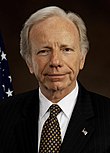Election to the United States Senate in 2006
On November 7, 2006, elections to the United States Senate were held. There were 33 of the 100 seats to choose from ( Class I ). The Democrats were able to take the majority from the Republicans . The election was part of the mid-term election between the presidential elections.
The term of office of the 110th Senate runs from January 4, 2007 to January 3, 2009.
Starting position
In the 109th Senate, the Republicans had a majority with 55 seats, ahead of the opposition Democrats with 44 seats. One seat was held by a non-party who, however, regularly voted with the Democrats.
Of the seats available for election, 17 were held by Democrats and 15 by Republicans. In order to get a majority in the Senate, the Democrats had to win 6 additional seats, with the independent candidates Joe Lieberman from Connecticut and Bernie Sanders from Vermont had already announced before the election that if they won a parliamentary group ("caucus") with the To enter democrats.
On the other hand, the Republicans could lose up to 5 seats without affecting the majority, since Dick Cheney, as Vice President of the United States and President of the Senate, gives the Republicans the decisive vote in the event of a tie. However, since the Senate's rules of procedure mean that there is only 60 votes for a “working” majority - enough votes to end a filibuster - there were incentives for both parties to fight for each candidate seat.
Even more so than in the House of Representatives, the Senate has experienced that current incumbents are difficult to defeat. Accordingly, the most controversial seats are also those whose current owner does not run for election again or has only been elected once. In the run-up to the election, according to the Cook Political Report, the states of Missouri, Montana, Ohio, Pennsylvania, Rhode Island, Virginia, Tennessee, New Jersey, Maryland, Arizona, Michigan, Washington and Minnesota were decisive for the election. The remaining 20 states were considered solidly Republican or Democratic. In Connecticut, the choice would be between the independent candidate Lieberman and the Democrat Lamont. The election of the independent candidate Sanders in Vermont was considered certain, according to the political institute.
In the 2006 congressional elections, there were four seats whose incumbents did not run:
- Mark Dayton for Minnesota (Democrat),
- Bill Deadline for Tennessee (Republican),
- Jim Jeffords for Vermont (non-party) and
- Paul Sarbanes for Maryland (Democrat).
Overall, a Democratic victory was thought possible but unlikely.
Election results
Summary
After the 2006 election, the Republican faction had 49 and the Democratic faction 51 members.
Although the Democratic Party only had 49 seats after the elections, it will be joined by two independent candidates in the Senate. For example, Senator Bernie Sanders , who does not belong to any party, will be a member of the Democratic Group. Senator Joe Lieberman ran as an independent candidate after losing the Connecticut Democratic primary, but remains a member of the Democratic Party and will also be a member of the Democratic Group. Towards the end, the Senate race came down to the majority in the states of Montana and Virginia . Previously there were 49 seats for the Republicans to 49 seats for the Democrats (including Sanders and Lieberman). Ultimately, the majority in both contested states tipped in favor of the democratic applicants. The decision in Virginia was so tight that the defeated Republican candidate George Allen could have required a recount by law, but waived it.
The Democrats succeeded in beating the Republican incumbent in six states, namely in Rhode Island , Pennsylvania , Missouri , Ohio , Montana and Virginia . In particular, the defeats of the two Republican heavyweights Rick Santorum in Pennsylvania and Allen in Virginia caused a national sensation. Both had considered running for the presidency in 2008, and George Allen in particular was considered a safe bet. But he weakened himself through rash remarks in the election campaign that were viewed as racist.
Overall results
| Political party | Last choice | Fixed seats | Won | Result | change | |
|---|---|---|---|---|---|---|
| republican | 55 | 40 | 9 | 49 | −6 | |
| Democrats | 44 | 27 | 22nd | 49 | +5 | |
| Other | 1 | - | 2 | 2 | +1 | |
see also: List of Senate Members of the 110th United States Congress
Election result by state
| State | republican | Democrats | Other | ||||||
|---|---|---|---|---|---|---|---|---|---|
| be right | proportion of | be right | proportion of | be right | proportion of | ||||
| Arizona | 814.393 | 53% | 664.137 | 44% | 48,230 | 3% | |||
| Connecticut | 109,196 | 10% | 450,837 | 40% | 574.729 | 50% | |||
| Delaware | 69,734 | 29% | 170,567 | 70% | 2,671 | 1 % | |||
| Florida | 1,826,127 | 38% | 2,890,548 | 60% | 76,859 | 2% | |||
| Hawaii | 126.075 | 37% | 210.311 | 61% | 6,412 | 2% | |||
| Indiana | 1,171,256 | 87% | - | - | 169.424 | 13% | |||
| California | 2,817,841 | 35% | 4,757,569 | 59% | 437.922 | 6% | |||
| Maine | 394,578 | 74% | 108,857 | 21% | 27,586 | 5% | |||
| Maryland | 684.618 | 44% | 855.563 | 54% | 24,914 | 2% | |||
| Massachusetts | 658.374 | 31% | 1,497,304 | 69% | - | - | |||
| Michigan | 1,560,297 | 41% | 2,151,087 | 57% | 69,263 | 2% | |||
| Minnesota | 835.670 | 38% | 1,278,911 | 58% | 88,245 | 4% | |||
| Mississippi | 375.307 | 64% | 205,518 | 35% | 9,099 | 2% | |||
| Missouri | 987.383 | 47% | 1,028,920 | 49% | 65,023 | 4% | |||
| Montana | 195.456 | 48% | 198,304 | 49% | 10,324 | 3% | |||
| Nebraska | 210,826 | 36% | 371.334 | 64% | - | - | |||
| Nevada | 322,366 | 55% | 238,663 | 41% | 21,263 | 4% | |||
| New Jersey | 975,389 | 45% | 1,162,054 | 53% | 49,869 | 2% | |||
| New Mexico | 163.732 | 29% | 394.079 | 71% | 376 | 0% | |||
| new York | 1,328,423 | 31% | 2,816,714 | 67% | 86,681 | 2% | |||
| North Dakota | 64,304 | 29% | 149.936 | 69% | 3,582 | 2% | |||
| Ohio | 1,680,999 | 44% | 2,133,690 | 56% | - | - | |||
| Pennsylvania | 1,652,420 | 41% | 2,343,727 | 59% | - | - | |||
| Rhode Island | 178,548 | 47% | 205.274 | 53% | - | - | |||
| Tennessee | 927,343 | 51% | 877.716 | 48% | 23,663 | 1 % | |||
| Texas | 2,659,380 | 62% | 1,554,483 | 36% | 97,622 | 2% | |||
| Utah | 344,416 | 63% | 169.369 | 31% | 36,190 | 6% | |||
| Vermont | 84,517 | 32% | - | - | 176,422 | 68% | |||
| Virginia | 1,165,324 | 49% | 1,172,541 | 50% | 26,102 | 1 % | |||
| Washington | 818,593 | 40% | 1.160.157 | 57% | 65,073 | 3% | |||
| West Virginia | 153.001 | 34% | 293,605 | 64% | 8,473 | 2% | |||
| Wisconsin | 629.127 | 30% | 1,436,623 | 67% | 66,704 | 3% | |||
| Wyoming | 134,942 | 70% | 57,640 | 30% | - | - | |||
Individual senate races
Connecticut
The former Democratic incumbent Joe Lieberman ran as an independent because he was defeated in his party's primary on August 8, 2006 Ned Lamont . Lieberman was heavily criticized in the Democratic Party for his support for the Iraq war . Alan Schlesinger ran for the Republicans .
In the end, Lieberman prevailed with 50% of the vote. Lamont received 40% of the vote and Schlesinger 10% of the vote. Many Republicans voted for Lieberman on this. The Republican Schlesinger had no chance from the start and could not hope for the support of his party. Nevertheless, Lieberman was subsequently a member of the Democratic Group.
Missouri
The Republican Jim Talent had narrowly prevailed against the Democratic incumbent Jean Carnahan in a special election in 2002 . Her husband Mel Carnahan died in a plane crash shortly before the Senate election in 2000, but still won more votes than John Ashcroft . As a result, his wife was appointed senator.
For the Democratic Party, Claire McCaskill competed against talent. The main topics in the election campaign were a referendum on stem cell research and an increase in the statutory minimum wage . Senator Talent spoke out against stem cell research and the minimum wage increase, while his Democratic challenger supported both proposals. In a campaign spot for McCaskill, Parkinson's disease actor Michael J. Fox also spoke out in favor of legalizing stem cell research.
The race was one of the most exciting and balanced. According to surveys before the election, both applicants were tied. Eventually McCaskill prevailed over Talent with a 50% to 47% vote.
Montana
The Republican incumbent Conrad Burns won the election in 2000 before the Democrat Brian Schweitzer , who later became governor of Montana, by a wafer-thin 3% advantage, although George W. Bush won the presidential election of Montana by over 20%. Together with Burns' alleged involvement in the Jack Abramoff affair and the strengthening of the Democratic Party in Montana, one of the most important races of this year developed. The Democratic Chairman of the Montana Senate , Jon Tester , competed against Burns .
For a long time the outcome of the race was completely open. But here, too, the Democratic applicant tester was able to prevail against the incumbent Burns with a wafer-thin lead.
New Jersey
Democrat Jon Corzine , who won the Senate seat for New Jersey in 2000, was elected governor of the state in 2005. Corzine named House Representative Bob Menendez to succeed him. For the Republicans came Thomas Kean Jr. , the son of former New Jersey Governor Thomas Kean . The race was considered one of the most important of the year and was probably the only way for the Republicans to take a seat in the Senate from the Democrats. While Kean was still ahead of Menendez in some polls in the summer, the tide turned in favor of the Democrat at the beginning of October. New Jersey is a democratic stronghold and last voted for a Republican Senate candidate in 1972. In the end, Menendez was able to prevail.
new York
Incumbent Hillary Clinton , the wife of former US President Bill Clinton , was able to assert herself clearly against the Republican and Mayor of the city of Yonkers , John Spencer . Although it was foreseeable before the election that Clinton would be re-elected, the former first lady's race attracted a lot of media interest. However, Senator Clinton was less of interest than the possible presidential candidate for the 2008 presidential election . While Clinton kept a low profile and just didn't want to rule this out, Spencer emphasized that he had no ambitions for the presidency and, unlike Clinton, wanted to stay in the Senate for a full six years.
Ohio
Re-election of Senator Mike DeWine was hampered by a corruption affair with the Republican Party in Ohio and the low popularity of Republican Governor Bob Taft . The Democratic candidate was the House of Representatives Sherrod Brown . This ultimately won the election.
Pennsylvania
Republican incumbent Rick Santorum competed against Democrat Bob Casey . Santorum has a reputation for being particularly conservative and is a strong voice for its party. Santorum's seat was considered the main target of the Democrats. Santorum lost its seat surprisingly clearly to the democratic challenger Casey.
Rhode Island
Senator Lincoln Chafee was considered one of the most liberal Republicans in the US Senate. Nevertheless, he was faced with a complicated situation, because his Democratic challenger Sheldon Whitehouse is also liberal and was therefore favored in Rhode Island, which is already leaning towards the Democrats. Rhode Island was also the state with the greatest opposition to then President George W. Bush. Only around a quarter of the population was satisfied with his administration.
Ultimately, Whitehouse was able to prevail against Chafee.
Tennessee
Senator Bill Frist , the Senate majority leader at the time, had announced that he would leave his seat at the end of his second term. It was assumed that Deadline was interested in running for the 2008 presidential election .
Although the votes of Tennessee in Electoral College in 2000 and 2004 went to George W. Bush, the majority of elected officials in the state are Democrats. Likewise, the majority of registered voters in Tennessee are Democrats and the majority of state seats in the House of Representatives are occupied by Democrats.
The Democratic candidate for the Senate seat was Harold Ford Jr. , a member of the House of Representatives since 1997, who met Republican Bob Corker in the election . The race was long considered very open. In the end, the Republican Corker was able to prevail against Ford with a thin majority. The election campaign in Tennessee was overshadowed by negative campaigning . In a TV commercial, for example, Ford was alleged to have attended Playboy parties, and it was suggested that, as a black man, he was primarily interested in white women.
Vermont
Senator Jim Jeffords left the Republican Party shortly after his election in 2000. On April 20, 2005, he announced that he would not run again. The Democratic Party did not put up a candidate of its own, as there are already several democratically inclined non-party candidates in the running, in particular Bernie Sanders , Vermont's only MP since 1991.
Richard Tarrant ran for the Republican side. Sanders prevailed over Tarrant by a large margin. He is considered a socialist and joined the Democrats in the Senate.
Virginia
Senator George Allen , believed to be a possible candidate for the 2008 presidential election , ran against Democrat and former Naval Secretary of State , Jim Webb . This seat was considered safe for everyone in early 2006, but his lead shrank due to ambivalent actions and racist remarks during his campaign appearances. In mid-August For example, he referred to an election worker of his democratic opponent, Shekar Ramanuja Sidarth, as a “ macaque ” and greeted him with: “Welcome to America”, although the man of Indian origin was born in the USA.
The outcome of Virginia was considered to be uncertain until the very end and the expected photo finish came about. Webb was able to prevail against everyone.
See also
Web links
see the article Mid-term elections in the United States in 2006 .
swell
- ↑ - ( Memento of the original from September 27, 2007 in the Internet Archive ) Info: The archive link was inserted automatically and has not yet been checked. Please check the original and archive link according to the instructions and then remove this notice.
- ↑ Seats that will not be voted on this year due to the staggered electoral system
- ↑ The independent candidate Bernie Sanders was elected Senator for the state of Vermont. The Democratic Party refrained from nominating an opponent. The newly elected Senator Joe Lieberman ran as an independent candidate against the candidates of the Democratic and Republican parties . However, both will belong to the Democratic Group ("caucus") in the newly constituted Senate.
- ↑ http://www.latimes.com/news/politics/la-na-poll25oct25,0,2498438.story?coll=la-home-headlines















